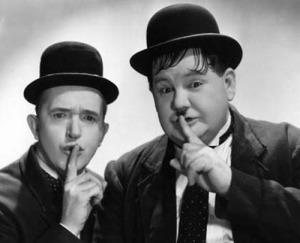Laurel y Hardy en Español
May 10, 2012
Once a month, every month, the Niles Essanay Silent Film Museum in Fremont screens an afternoon’s worth of Laurel and Hardy films. This month’s matinee, chosen from early in the comic duo’s long career, is something unusual.
After making names for themselves in the 1910s, Stan Laurel and Oliver Hardy teamed up in the mid-1920s and soon found a following; like other stars, they saw their silent movies translated into various languages for worldwide distribution.
Also around this time (the late 1920′s), movie studios began transitioning to sound. Once “the talkies” came in full force – and actors needed to speak, translating dialogue cards would no longer suffice as a means of reaching moviegoers in other countries.
During this transitional period, producer Hal Roach sought to retain Laurel and Hardy’s worldwide audience by shooting alternative language versions of their new English-language films. Laurel and Hardy had a huge following in South America, for example, and ten of their movies released between 1929 and 1931 were given the “multilingual treatment” and remade in other languages including Spanish, French, German and Italian.
Many early sound films were recorded on disc, and simply dubbing the voices of Laurel and Hardy or any other actor in other languages was impractical, if not then technically impossible. The solution at the Hal Roach Studios, where the comedy team made most of their early films, was to shoot each film over again in a different language.
The comedic duo spoke their lines phonetically, and things came off pretty well, in part because the stars were supported by a changing group of secondary cast members who spoke the given language of each remade film. As neither Stan nor Ollie spoke Spanish, their lines were written on a blackboard just out of camera range.
Stan Laurel on the set with his English-language, Spanish-language, and French-language wives. Polyglot polyamory or polyamory polyglot?
That’s the story behind the two Spanish-language Laurel and Hardy films set to play on Sunday, May 13 at Niles Essanay. The East Bay film museum will show the rarely screened La Vida Nocturna (a Spanish version of Blotto) and Noche De Nuedes (a Spanish version of two combined shorts, The Laurel and Hardy Murder Case and Berthmarks). Each date from 1930, and each feature English sub-titles.
Besides foreign markets, Spanish-language versions of Hollywood movies were also shown in theaters in the United States, especially those in areas with a large Spanish speaking population, such as New York City and the state of Texas. (Whether Spanish-language films were shown here in the Bay Area during the early sound era is unknown.) At the time, interestingly, there was a Spanish-language fan magazine published in the United States called Cinelandia.
If you are a Laurel and Hardy fan, the reason to view these films is more than just the novelty of hearing them in a foreign tongue. Along with cast changes, additional scenes not found in the English language versions were filmed in order to expand the original 20 minute shorts to near feature length. That’s the case with La Vida Nocturna, whose title was also changed from Blotto (a reference to the state The Boys got in after indulging in their bad habit) to what translates as “The Night Life.”
Those new scenes included comedy bits possibly intended for the English language version which ended up on the cutting room floor, or bits in which the two comedians improvise and added material as the film was being made. Other new material in these foreign-language versions meant to appeal to viewers in foreign countries might also include ethnic flourishes or characters or performances by ethnic musicians and stage talent. Additionally, in the case of La Vida Nocturna, the Spanish-version has an original 1930 underscoring which is no longer heard on American prints of Blotto, all of which now derive from a 1937 reissue which has a then updated score.
Detailing the differences in versions of these films might seem like a cinematic trainspotting exercise, but it also shines a spotlight on the film industry at a time of change – which makes for interesting film history.
Wordless beauty: this should make you smile.
The Laurel & Hardy Talkie Matinee, featuring two Spanish-language films, is set to play on Sunday, May 13 at 4:00 pm. Prior to the films, at 3:00 pm, the Midnight Patrol Tent of the “Sons of the Desert,” the local chapter of International Laurel & Hardy appreciation society, will meet at the Edison Theater. The public is welcome to attend their informal meeting.
For more info: The Niles Essanay Silent Film Museum is located at 37417 Niles Blvd. in Fremont, California. For further information, call (510) 494-1411 or visit the Museum’s website at www.nilesfilmmuseum.org.
Thomas Gladysz is a Bay Area arts journalist and early film buff, and the Director of the Louise Brooks Society, an internet-based archive and international fan club devoted to the silent film star. Gladysz has contributed to books on the actress, organized exhibits, appeared on television and radio, and introduced Brooks’ films around the world, but alas always in English.

